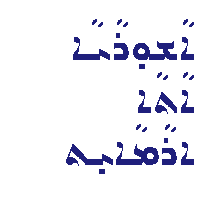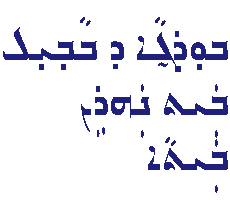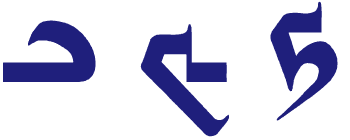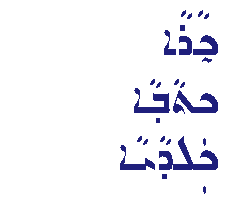LEARN ASSYRIAN ONLINE
THE ARAMAIC ALPHABET
SYRIAC-ARAMAIC VOCABULARY


Grab a sheet of lined paper, review the pronounciation, and practice each A-TOO-TAA (letter) 10 times, and educate yourself. Along with knowledge comes pride. Along with pride comes confidence. Confidence in yourself reflects the confidence people have in you. With pride, confidence, and knowledge, our nation will survive for 100 more generations.
Remember, as one of the first Christians (a couple years after the life of Christ), you speak one of the oldest, rarest language in the world. The language of God!!! Be proud of that. It is the root language of hebrew, arabic, turkish, and the alphabet for farsi (Persian), urdu (Pakistan/Indian), and greek. Aramaic replaced our ancient brethren's language, Akkadian (the oldest semetic language) around 1000 B.C.. The aramaic script was in turn derived from the Phonecians who probably extracted it from Canaan. After the Assyrians accepted the language of the Aramaens, Aramaic became the lingua franca of Mesopotamia and the whole middle-east. The word Aramaic comes from the word Aram, the son of Shem (of which the word SHE-MAA-YAA (Semetic) is derived).
There are two major dialects, Western (also refered to as Palastinian dialect (the dialect of EE-SHO (Jesus)) and Eastern (also referred to as "Syriac dialect" ("Syriac" is a dialect of Aramaic, not a language. Syriac also has Akkadian influences)). To say Modern Aramaic or Modern Syriac, you must be consistent and say Modern Hebrew, Modern English, Modern Greek, etc. for all languages follow the law of evolution. "Modern" is omitted when referring to any language. However, our language comparitivly has changed very little in 2000 years, especially lituraturally and liturgically.
Parts of the bible were written in aramaic, including the books of Erza and Daniel. The famous writing on the wallŒ, which was seen by Nebuchadnezzar's grandson, Belshazzar, told of the fall of Babylon. Later that night, Belshazar died and Cyrus the Persian and Darius the Mede conquered Babylon. The famous painting by Rembrandt incorrectly showed the handwriting as hebrew, because he could not find people who knew the script (He should have asked any Assyrian). The famous last words of Jesus were in his native tounge, aramaic,
(E-LEE E-LEE L-MAA-NAA SAA-BAACH-TAA-NEE) = (My God, my God, why have you forsaken me).
Celebrate the native tounge of Jesus, the language He preached in, the language of the Assyrians. The language is so valued that it is extensivly studied at the vatican and taught in ivy league schools such as Harvard University and the University of Chicago (just to name a couple). Learn to read and write as He did. It is an absorbing feeling. Challenge yourself to find a more asthetically beautiful script. Alaha umokhoon (God be with (all of) you).
Download this 41 page, adobe formatted file, ARAMAIC.PDF, if you intend on printing this web page. Get the adobe reader. It has been retyped and has a more professional format, includes the vowels and estrangela letters, and has more words and more words spelled out. You can also read it offline.
Remember, we write from right to left. (say that 10 times). If your interested in learning more Syriac-Aramaic, you may want to check out the "Songs of Assyria" page. Juliana Jendo's song "Alap Beet" is the best and quickest way to learn the ATWAT'E (letters).
With these 22 AT-WAA-TEH (letters) and 7 ZO-WEH (vowels), you should learn 69 words. You will get used to the pronounciation of the letters and the HAAJ-YAAT (spelling) of the words in Aramaic will come almost naturally and fall in place. 85% of the Assyrian words are written phonetically, that is they are spelled as they are pronounced (like the Spanish language). This makes spelling very easy.
Just follow these steps, and within two months (if you speak a little Assyrian) you shall start to read and write Assyrian (Believe me). After you learn, you will realize how easy it really was.
- Learn Juliana's "Alap Beet" song.
- Practice each A-TOO-TAA until you memorize each one of them.
- Learn the ZOW'E (Vowels) and how they are used.
- Practice assembling the AT-WAA-TEH to construct words according to how each A-TOO-TAA sounds. Begin with your name.
The HAAJ-YAAT (spelling) is not important now.
- Practice reading and writing with your new skills.
HIGHLY RECOMMENED!! Get the "Classical Aramaic" book (written by Rocco A. Errico and Michael J. Bazzi). Get the "Learning Syriac CD". The benifits will be enormous. Also, download these images and use one as your desktop background. Click here for the Letters image. Click here for the Vowels image.
Don't forget the at the end of this page. It contains a wealth of information to build your LOO-GHAA-TAA (vocabulary).
Three ATWAT'E have a final form that are placed at the end of the word. Kap, Meem, and Noon..
If you see an Alap in this form,, it is the Estrangela AT-WAA-TEH. The Estrangela set is mainly used for scriptures, titles, headings, and book and album titles. It usually has no ZO-WEH (vowels). Only 6 AT-WAA-TEH (letters) are different, the rest are the same. Click here to learn the Estrangela letters and learn more important words.
The History of Aramaic is at your disposal.
Learn to read, write, and type the Aramaic language is five minutes. Watch the video. Download the fonts and watch the video on how to type on your PC.
If you intend on printing this web page, download this 41 page, adobe formatted file, ARAMAIC.PDF.
Also download The Most Commonly Misused Assyrian Words
The Assyrian (Syriac-Aramaic) blocks are here.
| AA-SHOO-RRAA-YAA (m) // AA-SHOO-RRE-TAA (f) - - - - "People of Ashur" AA-TAA - - - - flag |
 |
Writing the letter |
|
| |
 |
| BOORR-JAA D BAA-VIL - - - - Tower of Babylon |

|
Writing the letter |
|
| |
 |


  KAP(Equivilant "K") |
|
| CHAA-RRAA - - - - remedy / solution / that which corrects or counteracts an evil of any kind. KTAA-VAA - - - KAA-TAA-VAA - - - - book / letter / mail KAA-TAA-VAA = writer (one who writes). BET URR-KEH = house of archives (library) KAAL-DAA-YAA (M)/ KUL-DE-TAA (F) - - - - a Chaldean (a tribe of Babylon) person. In modern times, "Chaldean" is a misnomer for "Assyrian-Catholic". Rome (which hates and envies the stubborn Eastern-Orthodox Assyrians for their triumphs over Asia and there unwillingness to accept Roman rule and Catholic doctrine) ,siezed their opprotunity to divide us (very succesfully). Instigated in 1551 by Pope Julius III and sealed with the consent of the Ottomans (in conjuntion with Rome) in 1844. Read the full details part one and part two. Written by an "Assyrian-Catholic". Rome acknowledges it's role in the "Chaldean" division, so should you. |
 |
Writing the letter |
|
| |
 |


Special Notes
The sentence structure is close to that of latin languages like
Spanish or French. Instead of saying "Sargon's book", we say,
"book of Sargon" (KTAA-VAA D SARR-GON), or, instead of "Assyrian flag",
we say "Flag of Assyria" (AA-TAA D AA-TORR).
Other grammatical rules would be object-adjective instead of
adjective-object. So instead of saying "large tower", we say
"tower large" (BOORR-JAA GOO-RRAA), or, instead of "dark tea", we say,
"tea dark" (CHAAY TOKH). If you translate directly from English,
you may confuse yourself. If you know the basics of a latin
language or other semetic languages, these rules should be very easy to
comprehend.
Don't worry about this now, but when you excel in the Aramaic language, keep these letters in mind.
![]() ,
, ![]() and
and ![]() . By themselves, they mean something and are combined with the the second word of a combination sentence.
. By themselves, they mean something and are combined with the the second word of a combination sentence.
![]() (pronounced ID when combined)
= of / symbolizes possesion
(pronounced ID when combined)
= of / symbolizes possesion
![]() (pronounced IL when combined) = on / onto / to
(pronounced IL when combined) = on / onto / to
![]() (pronounced OO when combined) = and
(pronounced OO when combined) = and
In this lesson, I separate the letter from the combined word to make it
easier to differentiate. For example, if the word begins with d
or the AD@ sounding letter, d . It is easier in the
beginning to read and write "go to nineveh" than "go tonineveh"
or "love and unity" than "love andunity", or "flag of Assyria" than
"flag ofAssyria".
Click to listen to below words.
![]() (AA-TAA D AA-TOR) should be written
(AA-TAA D AA-TOR) should be written ![]() .
.
It also should be pronounced, AA-TID AA-TORR.
![]() (KHOO-BAA OO KHOO-YAA-DAA) should be written
(KHOO-BAA OO KHOO-YAA-DAA) should be written ![]() .
.
When using Waw as the word Aand@, it is pronounced the same as above.
![]() (KHOOSH L NIN-WAA) should be written
(KHOOSH L NIN-WAA) should be written ![]() .
.
It also should be pronounced, KHOOSH-IL NIN-WAA.
Enjoy one of the three major languages of the bible (Hebrew and Greek are the others). It is through God's strength that our language has survived such enormous odds and tragedies, especially since 700AD. However, assimilation in the West cuts as a sword does in the East. Survival of the language begins with the individual.
 behind the words.
behind the words.